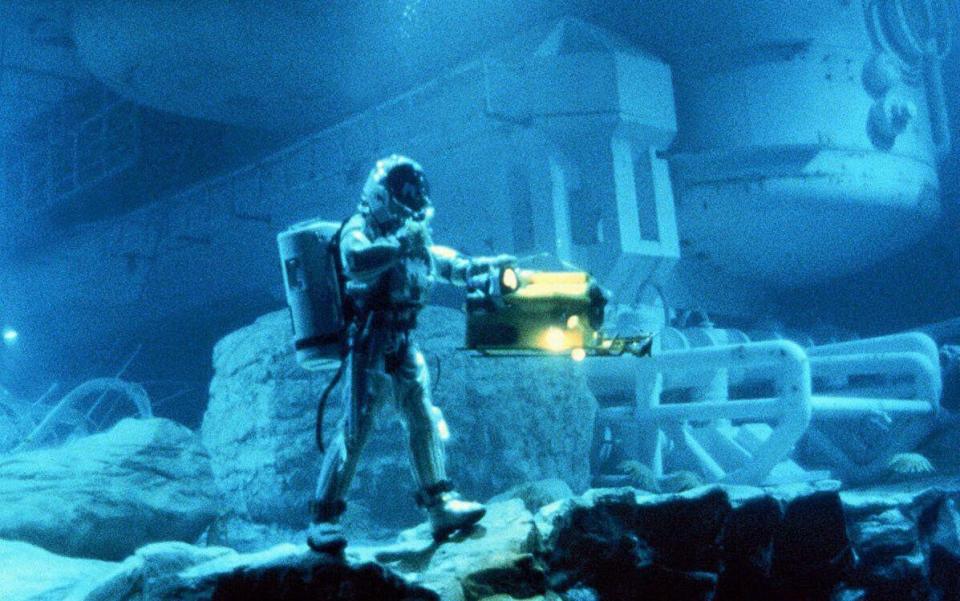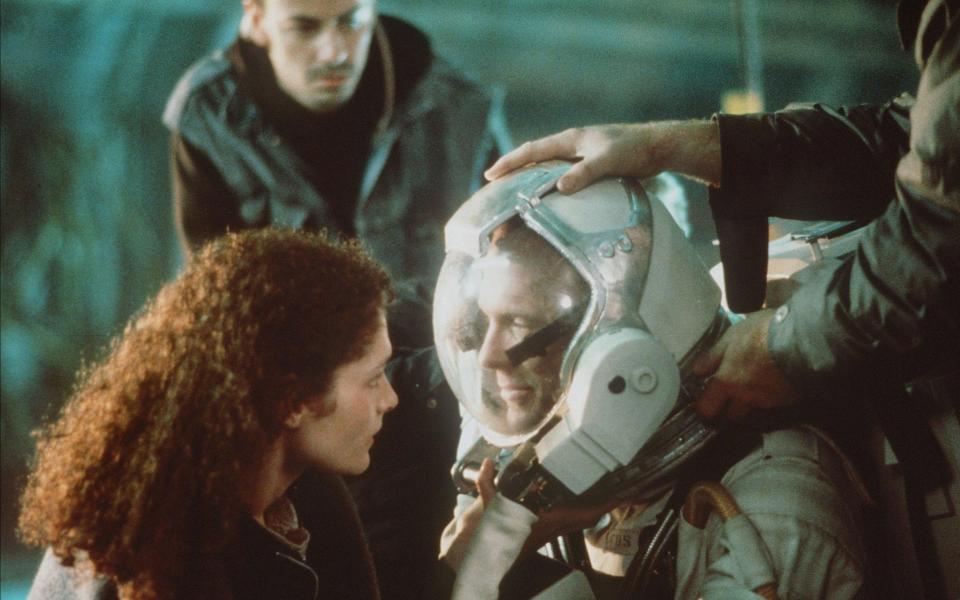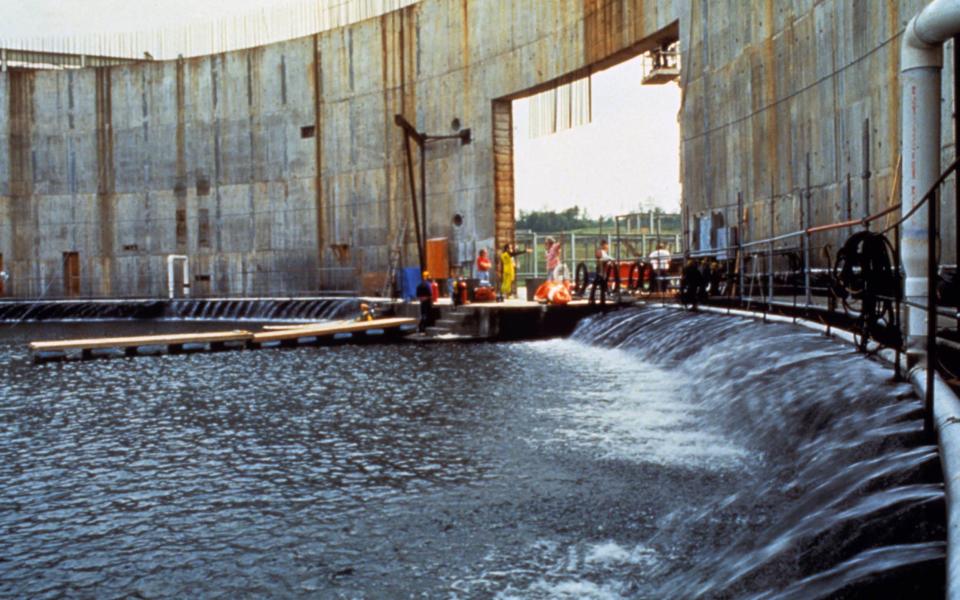‘We felt like soldiers in Vietnam’: the life and death making of The Abyss

Thirty feet beneath the surface of the water tank, Ed Harris was pretty sure he was going to die. Desperate to breathe between takes, he had signalled for his air supply to be brought over. It was jammed in his mouth, upside down. Air rushed into his lungs, but so did water. “For a brief second,” Harris said later, “I thought, ‘This is it.’”
Fortunately another diver arrived to jam his own regulator into Harris’s mouth. Later that night, in the car back to his hotel, Harris burst into tears. During the press junket for The Abyss, a journalist asked how he’d been treated on set. It was, Harris reflected, “like asking a soldier how he was treated in Vietnam”.
James Cameron had started thinking about the story which would become The Abyss by the age 16 - decades before turning Kate Winslet into a world-class free-diver for Avatar: the Way of Water. Already obsessed with French naval officer Jacques Cousteau, he attended a series of talks at a university in Buffalo, New York. One was given by a diver, who talked about an experimental new way of sending divers deeper into the ocean than ever before: by feeding their bodies oxygen in liquid form. Cameron was mind-blown.
His story was about the exploration of the 25,000-foot deep Cayman Trough in the western Caribbean. One by one, a group of divers using experimental liquid-breathing tech went down into the trench, never to return. After wondering whether to follow, the last decided to go in after them and attempt a rescue. Instead, he found himself completely overtaken by a kind of euphoria.
Looking for a story to follow Aliens he returned to his childhood idea, and reworked it as a Cold War nuclear thriller leading into an extraterrestrial invasion. Technically, The Abyss which would push filmmaking far beyond what had been possible before.
Al Giddings, who had shot underwater scenes for the post-Jaws underwater thriller The Deep, assured Cameron that what he wanted could be done. But as much as Cameron searched, he couldn’t find a water tank to shoot in. There were big tanks out there, of course. But they weren’t big enough for Cameron and Giddings.
Earl Owensby had been in the film business for nearly 20 years by the time he met James Cameron. This “twangy-voiced pneumatic tool salesman,” as the Chicago Tribune called him in 1985, had built his own myth in North Carolina. He styled himself ‘the Dixie DeMille’, an impresario who built a local film industry from next to nothing. For several years there was a wall filled with posters and mementoes from Owensby’s career at a local mall in the town of Shelby, right between a branch of Chick-Fil-A and the public toilets.
Though he was a Gone With the Wind megafan – the license plates on his truck read “GWTW I LOVE IT” – he made his mark knocking out low-budget grindhouse and pulp films with names like Frank Challenge: Manhunter and Death Driver, some of which he starred in despite having no previous acting experience. The Charlotte News noted that “he is not, to put it mildly, a captivating presence”.
When he had to deal with city types, Owensby deliberately played up his yokel schtick. “The trick was to cultivate this ‘aw, shucks’ image, and the more they [the press] wrote it, the better it was for me,” he said. But it was wearing thin.
“I think we’re changing that redneck image. It’s time to move on up.”
The opportunity came in 1987. Owensby had come into possession of an abandoned nuclear power station.

Construction work on Cherokee Nuclear Power Plant near Gaffney, South Carolina, started in the early 1970s. The plan was to build three great reactors to power the Carolinas. But as the economy wobbled and federal regulators started to insist on more oversight, the energy company Duke Power decided to pull out, having spent the equivalent of $1.4 billion today on the site. Owensby snapped it up.
Owensby invited Cameron and Giddings over to view the site, and on a cold, windy, wet day they wandered around its empty paths covered in weeds and office blocks which had never been used. Cameron was impressed, but what really piqued his interest was a vast structure a little way away: a gigantic cylinder of concrete.
He and Giddings clambered up a nearby crane which had been abandoned since construction stopped. The bowl, which had been intended to contain the nuclear reactor, was 240 feet across and had walls 80 feet high. Both men agreed they could build a tank big enough to fit their cliff face set inside. Of course, agreeing what to do was one thing.
“It’s very easy to say on land what you’re going to do,” Harris said later. “When you get down there, under 40 feet of water, all of a sudden things don’t work the same.”

Cameron was aware of that. “The classic problem with taking cast into the water is survival to script. It’s very hard to get someone past their immediate survival to the dramatic requirements of the shot you’re trying to do.”
Producer Gale Anne Hurd agreed. “We knew that their lives would really depend on their ability to survive anything that they could encounter during the filming process.”
Harris had had to get up to speed as a diver on his own, but was the most competent diver by the time shooting began. Even he felt deeply uncomfortable under the water at times. “The worst moments for me were being towed with fluid rushing up my nose and my eyes swelling up,” he recalled.
His co-stars were no less alarmed. Mary Elizabeth Mastrantonio, who played Harris’ character’s estranged wife, had to stare at the surface and the lights above it to stay calm. Michael Biehn, playing the deranged SEAL Lieutenant Coffey, felt foreboding too: “There were weights on our ankles and waist. If something went wrong, we couldn't swim to safety.”
Things did, frequently, go wrong. On the first day of shooting, the tank sprang a leak and 150,000 gallons of water spewed out. “It sounded like Niagara Falls,” Hurd told Total Film later.
Nature intervened too. A black tarpaulin which had been used to cover the tank and give the effect of night falling underwater was damaged in a storm. Instead of fixing it and wasting precious time the decision was taken to shoot through the night. A day’s shooting could last up to 18 hours.
“We'd jump in at seven in the evening and stay underwater until 12.30 or 1am,” Giddings said later. “We'd stagger out, astronaut-like, dizzy with weightlessness, drive a mile to the lunch area and under a full moon, in dripping wetsuits, eat our lunch. Toward the end it was so darn cold we'd fire up plastic hot tubs, and a dozen of us would slosh around in 100-degree water to shore us up for the next blitz. And we'd go back into the water from 2am until dawn.”

Biehn remembered getting diving gear on first thing in the morning, and a lot of waiting around. “Then the shot didn't happen at eight o'clock. It didn't happen at 12 o'clock. It didn't happen at four o'clock. I was in South Carolina for five months and there were only three or four weeks where I was acting.”
Even more irritating were the tiny black beads which Giddings had floated on the water’s surface to stop the set reflecting on its underside, and which got into ears, noses, and everywhere else nobody wanted them to be. Ear and sinus infections were rife. At one stage the tank was over-chlorinated, and ended up bleaching and even burning off some divers’ hair.
“I’m letting you breathe!” Cameron would shout at his crew, partly joking. “What more do you want?”
Every aspect of shooting was difficult, from lighting to moving cameras around to communications. A radio system based on fighter pilots’ comms systems was created, but Cameron’s feed was audible to cast and crew. “Jim enjoyed that,” Giddings later told Rebecca Keegan in her study of Cameron’s films, The Futurist. “It was a total dictator system.”
Despite that, other cast members managed to find a workaround. Leo Burmester remembered putting his helmet on other actors’ helmets and screaming as loud as he could, which got enough vibrations through to a colleague to hold a conversation.

Cameron retained his zeal. Each day he was forced to wait just under the surface before coming up to avoid getting the bends after filming, and so insisted on having dailies played on a screen in the tank’s control room so he could watch them through a window while he waited underwater.
Afterwards, Cameron would head back to his rented house in Gaffney and breath pure oxygen from a tank on medical advice. Exhausted, he would sometimes wake up fully dressed in the position he’d fallen asleep.
Then, during one day’s filming, the worst happened. Cameron went to take a breath and realised he had run out of oxygen completely. He used the last air in his lungs to ask for help, but nobody came.
Ditching his helmet, he attempted a ‘blow and go’ – what divers call a dash for the surface while exhaling, to make sure they don’t die from the air left in their bodies expanding as the pressure changes and making their lungs explode.
A diver caught up to Cameron and attempted to give him air from a regulator, but it was broken and spewed water into his lungs. Thinking Cameron was panicking, the diver grasped him closer and tried to force him to take the regulator again; Cameron punched him as hard as he could, and escaped.
Cameron just made it to the surface. It was, he told Rebecca Keegan, “a classic clusterf--k”. Later that day, though, he wanted his helmet retrieved from the bottom of the tank. He was ready to go again.
Though Cameron admitted mangling his own ending – an intended finale with a giant tsunami was pulled, to his later regret – The Abyss was a unique, innovative piece of moviemaking, and scratched an itch Cameron had harboured since childhood.
Harris was less starry eyed about the whole thing though: “It was a bitch.”

 Yahoo News
Yahoo News 